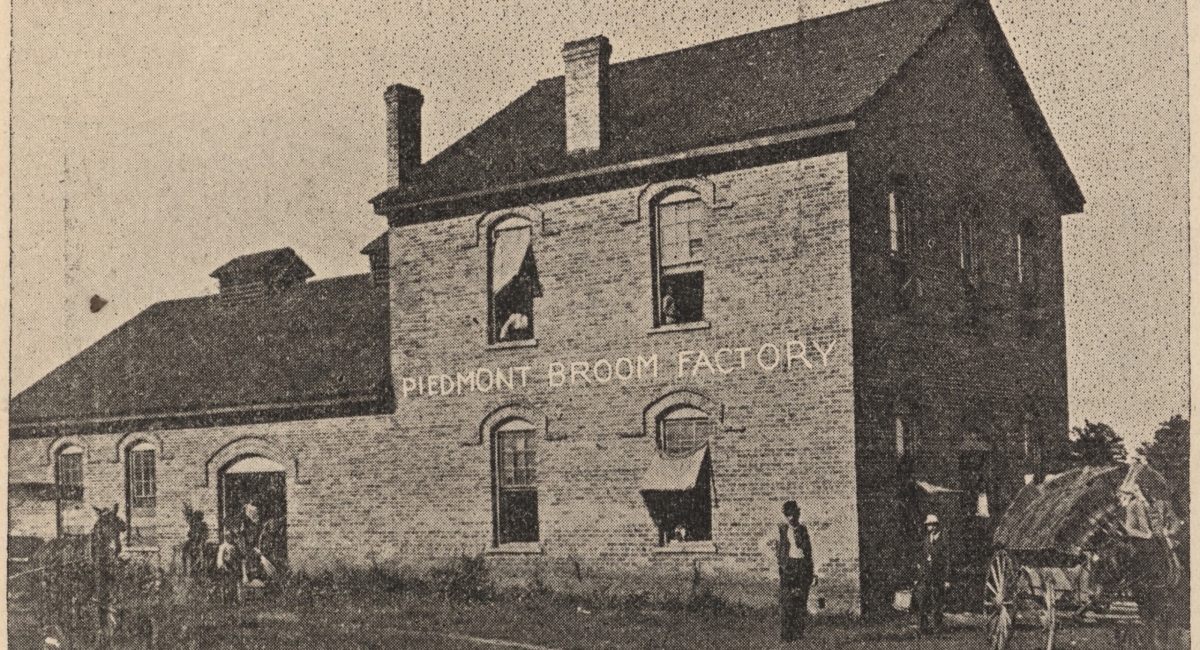During an era when Black laborers were blocked by law from working inside Spartanburg County’s numerous cotton mills, Muckenfuss Broom Works welcomed them for 50 years as employees on its shop floor. The factory, located along what is now known as East Daniel Morgan Avenue, grew to be the most significant broom manufacturer in the South, and many of its 20-plus jobs were filled by local Black men.
There was one other unusual feature of the Muckenfuss factory: its owner was completely blind.
Owner Wesley George Muckenfuss came from a prominent Charleston family with German roots. As a teenager without sight, he was sent to Spartanburg to attend Cedar Springs Institute, now known as the South Carolina School for the Deaf and the Blind. There, broom making was one of the traditional “blind trades” taught. At the age of 22, after attending Wofford College and graduating from the University of South Carolina, Muckenfuss opened his broom-making factory in a small wooden building near the Wofford campus, adjacent to the Southern Railway underpass—in the center of the emerging 300-acre Black neighborhood. Among his earliest employees were five young Black men: Laban Brown, Andrew Williams, Alex Smith, William Cooper and Columbus Holtsy. They and scores of other Black laborers over the years crafted “the brooms with the blue label,” some of the most coveted brooms on the East Coast and the Midwest.
Early laborers at Muckenfuss turned out nearly 50,000 brooms a year, along with a variety of brushes. “They make as good brooms as can be made anywhere in this country,” wrote The Atlanta Constitution in 1902, “and sell them to the trade direct from the factory through their own traveling salesmen.” On the night of Nov. 17, 1909, a fire of unknown origin burned the factory to the ground and consumed six cottages, all occupied by Black families. “For a time it seemed as if the whole section was threatened, including Fowler’s Row and the Silver Hill church neighborhood,” one journalist wrote. Residents “wild with fright” dragged possessions from the homes, but fortunately no one was killed. While the ruins still smoked, Muckenfuss proclaimed, “We are all young. The factory will be rebuilt.”
He was good to his word. In 1920 the new broom factory was producing three times the previous volume. By that time, though, Wesley Muckenfuss was gone. He died suddenly of heart failure at his home at 167 North Dean Street in 1914. His obituary described him as an expert typist who kept the books “neatly and accurately by a method of his own origination.” His wife, Rida, ran the factory in his place for many years. She continued to provide comparatively good jobs for Black laborers: Census data shows that Hughes Green, a resident of Cummings Street, made $780 a year at the factory in 1940—about twice what Black teachers of the period were paid.
The Muckenfuss era ended around 1945 when the company was merged with an out-of-town manufacturer. A Subaru dealership sits on the site today.
This Spotlight is an excerpt from North of Main: Spartanburg's Historic Black Neighborhoods of North Dean Street, Gas Bottom, and Back of the College by Brenda Lee Pryce, Jim Neighbors, and Betsy Wakefield Teter. Copies of the book can be purchased at the Hub City Bookshop or online.


